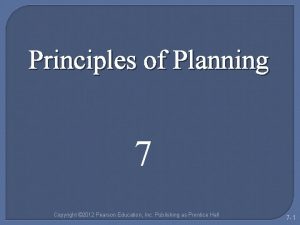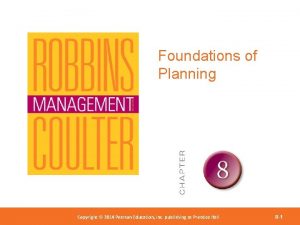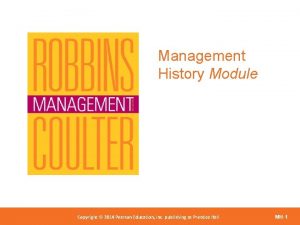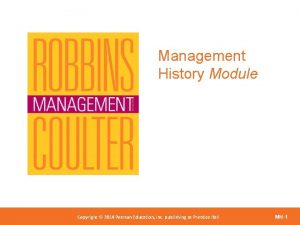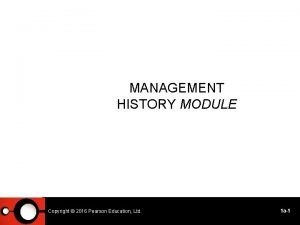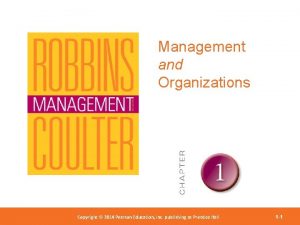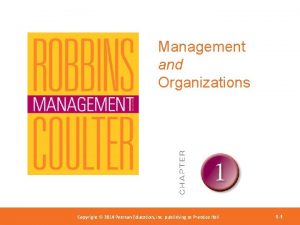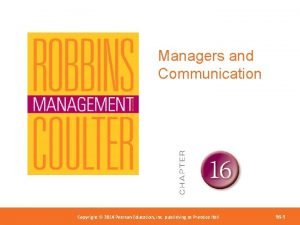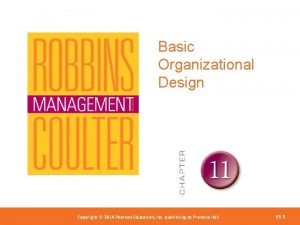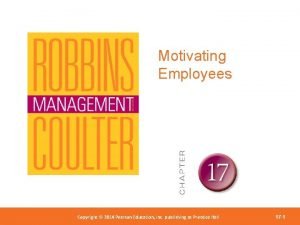Management History Module Copyright 2012 Pearson Education Copyright

















































- Slides: 49

Management History Module Copyright 2012 Pearson Education, Copyright © 2014 Pearson©Education, Inc. publishing as Prentice Hall Inc. Publishing as Prentice Hall MH-1

Describe some early management examples. Explain the various theories in the classical approach. Discuss the development and uses of the behavioral approach. Describe the quantitative approach. Explain the various theories in the contemporary approach. Copyright © Education, 2012 Pearson Copyright © 2014 Pearson Inc. Education, publishing. Inc. as Prentice Hall Publishing as Prentice Hall MH-2

Early Management • Ancient Management - Egypt (pyramids) and China (Great Wall) Copyright 2012 Pearson Education, Copyright © 2014 Pearson©Education, Inc. publishing as Prentice Hall Inc. Publishing as Prentice Hall MH-3

Early Management • Adam Smith The Wealth of Nations in 1776 – Division of labor (job specialization) - the breakdown of jobs into narrow and repetitive tasks. • Industrial Revolution – Substituted machine power for human labor – Created large organizations in need of management Copyright 2012 Pearson Education, Copyright © 2014 Pearson©Education, Inc. publishing as Prentice Hall Inc. Publishing as Prentice Hall MH-4

Exhibit MH-1 Major Approaches to Management Copyright 2012 Pearson Education, Copyright © 2014 Pearson©Education, Inc. publishing as Prentice Hall Inc. Publishing as Prentice Hall MH-5

Classical Approach • Classical approach - first studies of management, which emphasized rationality and making organizations and workers as efficient as possible Copyright 2012 Pearson Education, Copyright © 2014 Pearson©Education, Inc. publishing as Prentice Hall Inc. Publishing as Prentice Hall MH-6

Scientific Management • Fredrick Winslow Taylor – The “father” of scientific management • Scientific management - an approach that involves using the scientific method to find the “one best way” for a job to be done. Copyright 2012 Pearson Education, Copyright © 2014 Pearson©Education, Inc. publishing as Prentice Hall Inc. Publishing as Prentice Hall MH-7

Exhibit MH-2 Taylor’s Scientific Management Principles Copyright 2012 Pearson Education, Copyright © 2014 Pearson©Education, Inc. publishing as Prentice Hall Inc. Publishing as Prentice Hall MH-8

Frank and Lillian Gilbreth • Therbligs - a classification scheme for labeling basic hand motions Copyright 2012 Pearson Education, Copyright © 2014 Pearson©Education, Inc. publishing as Prentice Hall Inc. Publishing as Prentice Hall MH-9

General Administrative Theory • General administrative theory - an approach to management that focuses on describing what managers do and what constitutes good management practice Copyright 2012 Pearson Education, Copyright © 2014 Pearson©Education, Inc. publishing as Prentice Hall Inc. Publishing as Prentice Hall MH-10

Henri Fayol • Principles of management Fundamental rules of management that could be applied in all organizational situations and taught in schools Copyright 2012 Pearson Education, Copyright © 2014 Pearson©Education, Inc. publishing as Prentice Hall Inc. Publishing as Prentice Hall MH-11

Exhibit MH-3 Fayol’s 14 Principles of Management Copyright 2012 Pearson Education, Copyright © 2014 Pearson©Education, Inc. publishing as Prentice Hall Inc. Publishing as Prentice Hall MH-12

Exhibit MH-3 Fayol’s 14 Principles of Management (cont. ) Copyright 2012 Pearson Education, Copyright © 2014 Pearson©Education, Inc. publishing as Prentice Hall Inc. Publishing as Prentice Hall MH-13

General Administrative Theory (cont. ) • Bureaucracy a form of organization characterized by division of labor, a clearly defined hierarchy, detailed rules and regulations, and impersonal relationships Copyright 2012 Pearson Education, Copyright © 2014 Pearson©Education, Inc. publishing as Prentice Hall Inc. Publishing as Prentice Hall MH-14

Exhibit MH-4 Characteristics of Weber’s Bureaucracy Copyright 2012 Pearson Education, Copyright © 2014 Pearson©Education, Inc. publishing as Prentice Hall Inc. Publishing as Prentice Hall MH-15

Classical Management Approaches • Possible disadvantages of bureaucracy: – Excessive paperwork or “red tape” – Slowness in handling problems – Rigidity in the face of shifting needs – Resistance to change – Employee apathy Copyright © 2015 John

Behavioral Approach • Organizational behavior (OB) - the study of the actions of people at work. • Early OB Advocates – Robert Owen – Hugo Munsterberg – Mary Parker Follett – Chester Barnard Copyright 2012 Pearson Education, Copyright © 2014 Pearson©Education, Inc. publishing as Prentice Hall Inc. Publishing as Prentice Hall MH-17

Exhibit MH-5 Early OB Advocates Copyright 2012 Pearson Education, Copyright © 2014 Pearson©Education, Inc. publishing as Prentice Hall Inc. Publishing as Prentice Hall MH-18

Foundations in the behavioral or human resource approaches to management Hawthorne studies Elton Mayo Theory of human needs Abraham Maslow Organizations as communities Mary Parker Follett Human resource approaches Assumption: People are social and selfactualizing Theory X and Theory Y Douglas Mc. Gregor Personality and organization Chris Argyris Copyright © 2015 John

Behavioral Management Approaches • Follett’s Organizations as communities – Mary Parker Follett – Groups and human cooperation: • Groups allow individuals to combine their talents for a greater good • Organizations are cooperating “communities” of managers and workers • Manager’s job is to help people cooperate and achieve an integration of interests Copyright © 2015 John

Behavioral Management Approaches • Hawthorne studies – Initial study examined how economic incentives and physical conditions affected worker output – No consistent relationship found – “Psychological factors” influenced results Copyright © 2015 John

Behavioral Management Approaches • Hawthorne studies (cont. ) – Social setting and human relations • Manipulated physical work conditions to assess impact on output • Designed to minimize the “psychological factors” of previous experiment • Mayo and colleagues concluded: – New “social setting” led workers to do good job – Good “human relations” = higher productivity Copyright © 2015 John

Behavioral Management Approaches • Hawthorne studies (cont. ) – Employee attitudes and group processes • Some things satisfied some workers but not others • People restricted output to adhere to group norms Copyright © 2015 John

Behavioral Management Approaches • Lessons from the Hawthorne Studies: – Social and human concerns are keys to productivity – Hawthorne effect — people who are singled out for special attention perform as expected Copyright © 2015 John

Behavioral Management Approaches • Maslow’s theory of human needs – A need is a physiological or psychological deficiency a person feels compelled to satisfy – Need levels: • • • Physiological Safety Social Esteem Self-actualization Copyright © 2015 John

Figure 2. 3 Maslow’s hierarchy of human needs Copyright © 2015 John

Behavioral Management Approaches • Maslow’s theory of human needs – Deficit principle • A satisfied need is not a motivator of behavior – Progression principle • A need becomes a motivator once the preceding lower-level need is satisfied – Both principles cease to operate at selfactualization level Copyright © 2015 John

Behavioral Management approaches • Mc. Gregor’s Theory X assumes that workers: – – – Dislike work Lack ambition Are irresponsible Resist change Prefer to be led Copyright © 2015 John

Behavioral Management approaches • Mc. Gregor’s Theory Y assumes that workers are: – – – Willing to work Capable of self control Willing to accept responsibility Imaginative and creative Capable of self-direction Copyright © 2015 John

Behavioral Management Approaches • Implications of Theory X and Theory Y: – Managers create self-fulfilling prophecies – Theory X managers create situations where workers become dependent and reluctant – Theory Y managers create situations where workers respond with initiative and high performance • Central to notions of empowerment and selfmanagement Copyright © 2015 John

Behavioral Management Approaches • Argyris’s theory of adult personality – Classical management principles and practices inhibit worker maturation and are inconsistent with the mature adult personality – Psychological success occurs when people define own goals Copyright © 2015 John

Behavioral Management Approaches • Argyris’s theory of adult personality – Management practices should accommodate the mature personality by: • Increasing task responsibility • Increasing task variety • Using participative decision making Copyright © 2015 John

The Quantitative Approach • Quantitative approach - the use of quantitative techniques to improve decision making Copyright 2012 Pearson Education, Copyright © 2014 Pearson©Education, Inc. publishing as Prentice Hall Inc. Publishing as Prentice Hall MH-33

Total Quality Management (TQM) • Total quality management (TQM) - a philosophy of management that is driven by continuous improvement and responsiveness to customer needs and expectations Copyright 2012 Pearson Education, Copyright © 2014 Pearson©Education, Inc. publishing as Prentice Hall Inc. Publishing as Prentice Hall MH-34

Exhibit MH-6 What Is Quality Management? Copyright 2012 Pearson Education, Copyright © 2014 Pearson©Education, Inc. publishing as Prentice Hall Inc. Publishing as Prentice Hall MH-35

Contemporary Approaches • System - a set of interrelated and interdependent parts arranged in a manner that produces a unified whole. • Closed system - systems that are not influenced by and do not interact with their environment • Open system - systems that interact with their environment Copyright 2012 Pearson Education, Copyright © 2014 Pearson©Education, Inc. publishing as Prentice Hall Inc. Publishing as Prentice Hall MH-36

Exhibit MH-7 Organization as an Open System Copyright 2012 Pearson Education, Copyright © 2014 Pearson©Education, Inc. publishing as Prentice Hall Inc. Publishing as Prentice Hall MH-37

The Contingency Approach • Contingency approach - a management approach that recognizes organizations as different, which means they face different situations (contingencies) and require different ways of managing Copyright 2012 Pearson Education, Copyright © 2014 Pearson©Education, Inc. publishing as Prentice Hall Inc. Publishing as Prentice Hall MH-38

Exhibit MH-8 Popular Contingency Variables Copyright 2012 Pearson Education, Copyright © 2014 Pearson©Education, Inc. publishing as Prentice Hall Inc. Publishing as Prentice Hall MH-39

Modern Management Foundations • Evidence-Based Management – Making management decisions on “hard facts” about what really works Copyright © 2015 John

evidence-based management • Jeffrey Pfeffer and Robert Sutton make the case for evidencebased management, which involves making decisions based on hard facts about what really works. Accordingly, managers should make decisions based on: • • Practitioner expertise and judgment • Evidence from local context • Critical evaluation of the best available research evidence • Perspectives of those people who might be affected by the decision Copyright © 2015 John

• Managers can have more confidence in accepting and applying research that satisfies the following criteria: • • A research question or problem is clearly identified. • One or more hypotheses is stated to describe possible explanations. • The research design provides for a good test of the hypothesis. • Data are rigorously gathered, analyzed, and interpreted. • Hypotheses are accepted or rejected and conclusions made based on the evidence. Copyright © 2015 John

Review Learning Outcome MH-1 • Describe some early management examples. – Early examples of management practice in the construction of the Egyptian pyramids – Adam Smith’s Wealth of Nations argued the benefits of division of labor – In the industrial revolution where it became more economical to manufacture in factories than at home Copyright 2012 Pearson Education, Copyright © 2014 Pearson©Education, Inc. publishing as Prentice Hall Inc. Publishing as Prentice Hall MH-43

Review Learning Outcome MH-2 • Explain the various theories in the classical approach. – Frederick W. Taylor studied manual work using scientific principles – The Gilbreths’ studies efficient hand-body motions – Fayol believed the functions of management were common to all business endeavors Copyright 2012 Pearson Education, Copyright © 2014 Pearson©Education, Inc. publishing as Prentice Hall Inc. Publishing as Prentice Hall MH-44

Review Learning Outcome MH-2 (cont. ) • Fayol developed 14 principles of management • Weber described an ideal type of organization he called a bureaucracy Copyright 2012 Pearson Education, Copyright © 2014 Pearson©Education, Inc. publishing as Prentice Hall Inc. Publishing as Prentice Hall MH-45

Review Learning Outcome MH-3 • Discuss the development and uses of the behavioral approach. – Early OB advocates believed that people were the most important asset of the organization and should be managed accordingly. – The Hawthorne Studies dramatically affected management beliefs about the role of people in organizations Copyright 2012 Pearson Education, Copyright © 2014 Pearson©Education, Inc. publishing as Prentice Hall Inc. Publishing as Prentice Hall MH-46

Review Learning Outcome MH-4 • Describe the quantitative approach. – The quantitative approach involves applications of statistics, optimization models, information models, and computer simulations to management activities. – Total quality management—a management philosophy devoted to continual improvement and responding to customer needs and expectations—also makes use of quantitative methods to meet its goals Copyright 2012 Pearson Education, Copyright © 2014 Pearson©Education, Inc. publishing as Prentice Hall Inc. Publishing as Prentice Hall MH-47

Review Learning Outcome MH-5 • Explain the various theories in the contemporary approach. – The systems approach says that an organization takes in inputs (resources) from the environment and transforms them into outputs that are distributed into the environment – The contingency approach says that organizations are different, face different situations, and require different ways of managing Copyright 2012 Pearson Education, Copyright © 2014 Pearson©Education, Inc. publishing as Prentice Hall Inc. Publishing as Prentice Hall MH-48

Copyright © Education, 2012 Pearson Copyright © 2014 Pearson Inc. Education, publishing. Inc. as Prentice Hall Publishing as Prentice Hall MH-49
 Pearson education, inc. publishing as prentice hall
Pearson education, inc. publishing as prentice hall 2012 pearson education inc
2012 pearson education inc Pearson education 2012
Pearson education 2012 2012 pearson education inc
2012 pearson education inc Cranial cephalic
Cranial cephalic Pearson education inc. 2012
Pearson education inc. 2012 Pearson education inc. 2012
Pearson education inc. 2012 2012 pearson education inc anatomy and physiology
2012 pearson education inc anatomy and physiology 2012 pearson education inc
2012 pearson education inc 2012 pearson education inc
2012 pearson education inc Pearson education inc. 2012
Pearson education inc. 2012 2012 pearson education inc
2012 pearson education inc Pearson education 2012
Pearson education 2012 Pearson education inc. 2012
Pearson education inc. 2012 2012 pearson education inc
2012 pearson education inc 2012 pearson education inc
2012 pearson education inc 2012 pearson education inc
2012 pearson education inc Pearson 2012
Pearson 2012 Pearson education inc all rights reserved
Pearson education inc all rights reserved Pearson education 2011
Pearson education 2011 Pearson education inc publishing as pearson prentice hall
Pearson education inc publishing as pearson prentice hall Pearson education inc publishing as pearson prentice hall
Pearson education inc publishing as pearson prentice hall Copyright 2008
Copyright 2008 2017 pearson education inc
2017 pearson education inc 2017 pearson education inc
2017 pearson education inc Copyright 2010 pearson education inc
Copyright 2010 pearson education inc Copyright 2009 pearson education inc
Copyright 2009 pearson education inc 2018 pearson education inc
2018 pearson education inc 2014 pearson education inc
2014 pearson education inc Copyright 2010 pearson education inc
Copyright 2010 pearson education inc Copyright 2010 pearson education inc
Copyright 2010 pearson education inc Copyright by pearson education inc. answers
Copyright by pearson education inc. answers Copyright 2003 pearson education inc
Copyright 2003 pearson education inc Copyright 2009 pearson education inc
Copyright 2009 pearson education inc Copyright pearson education inc
Copyright pearson education inc Copyright 2010 pearson education inc
Copyright 2010 pearson education inc Copyright 2010 pearson education inc
Copyright 2010 pearson education inc Copyright 2010 pearson education inc
Copyright 2010 pearson education inc Copyright 2010 pearson education inc
Copyright 2010 pearson education inc Copyright 2010 pearson education inc
Copyright 2010 pearson education inc Copyright 2010 pearson education inc
Copyright 2010 pearson education inc Pearson education inc all rights reserved
Pearson education inc all rights reserved Copyright 2009 pearson education inc
Copyright 2009 pearson education inc Copyright 2009 pearson education inc
Copyright 2009 pearson education inc 2009 pearson education inc
2009 pearson education inc 2009 pearson education inc
2009 pearson education inc Copyright pearson education inc
Copyright pearson education inc Pearson 2012
Pearson 2012 Dentist copyright 2012
Dentist copyright 2012 Copyright 2012
Copyright 2012






